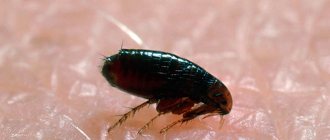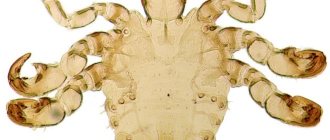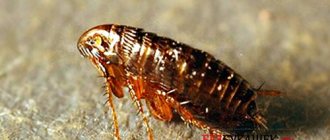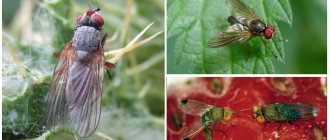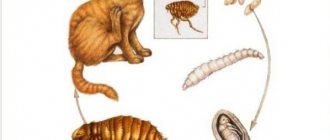What do fleas look like?
Fleas belong to a large order of insects, which include different subspecies. They feed on the blood of various animals and are parasites. Using a photo of fleas on a cat, you can determine the type of flea and understand that the animal is attacked by these insects.
The cat flea is one of the most common species; its body length reaches up to three millimeters. The flea has a body that is flattened on the sides, and their hind legs are very long.
- It is thanks to their long legs that they are so easily carried along the fur; female fleas are larger than males, since they lay eggs and carry them in their abdomen.
- The flea has a sucking and piercing mouth, with which it pierces the cat's skin and drinks its blood.
- There are many bristles on the surface of the flea's body, which also allows the parasite to cling tightly to the fur.
- The color of the flea can be light brown and reach black.
Recognizing parasites in cats
It is not necessary to have a veterinary degree to detect the presence of fleas. You should be alerted that your pet is acting restless, meowing loudly, and showing visible signs of irritation.
It is worth thinking about possible infection with these blood-sucking parasites if the cat has been outside for some time. Or came into contact with street animals. In this case, the probability of contracting entomosis is quite high. Even if you know how to tell if a cat has fleas, it won’t hurt to read about it again:
- To determine the presence of parasites in an animal, it is enough to examine the cat’s skin.
Insects accumulate in areas of thin skin. Most often behind the ears, armpits, on the head, stomach. Pests also like to settle at the base of the tail to lay their eggs there. If you run your hand against the fur, you will be able to notice nimble black or brown insects. Or the products of their vital activity in the form of black “peppercorns”; - You can tell if your cat has fleas or lice by checking its fur. In a sick animal, it is disheveled, not shiny, and lacks shine;
- You can find out that a cat has fleas by examining the animal’s skin: bites and marks from scratching will be red, with bruises. If there is an allergic reaction, the skin will be swollen and red;
How do fleas get started?
There are many ways your pet can become infected with parasites.
- Walk outside (fleas can be on the grass, ground and asphalt).
- Human contact (fleas can be brought home on clothing or shoes).
- Transmission from the mother (if a pregnant cat has fleas, there is a high chance that the parasites will be transmitted to newborn kittens).
- Contact with rodents.
Fleas: The Danger of Parasites
It is important to know that fleas on a domestic cat can be very dangerous for your pet.
- Fleas carry various diseases and even worm eggs.
- Because of the bites, wounds appear on the cat's skin, the fur becomes dull and begins to fall out.
- If the number of fleas constantly increases, this leads to feline anemia and negatively affects the health of the animal.
- Development of allergies.
Fleas particularly affect cats in poor health, as well as newborn kittens and older cats. In addition, the presence of fleas can be potentially dangerous for humans; if a flea gets into food, poisoning is possible. The parasite can bite through human skin, which will lead to dermatitis and various skin diseases.
Can a domestic cat get fleas?
Fleas often appear in cats that live at home and do not go outside at all. This can happen in several cases:
- There are also pets in the house who go for walks, and they shared fleas with the cat;
- the animal met its owner who came from the street, who brought fleas on his clothes;
- insects got into the apartment from neighbors, from the basement, from the landing, from the wind through the window;
- the cat was attacked by insects or larvae that had been living in the house for a long time.
Even if only one insect accidentally gets into the house, after a few days the number of parasites will increase significantly. Considering how easy it is for parasites to get into the house, owners of mustachioed pets should not be surprised why a domestic cat has fleas.
Symptoms of infection
Flea infestation has three main stages, each of which is accompanied by certain symptoms.
- Initial stage - at this stage, parasites can be detected if you carefully examine the cat's fur and skin.
- At the second stage, the pet’s health becomes worse, the cat becomes nervous and constantly chews something out of the fur, eats and sleeps poorly.
- The third stage is accompanied by severe hair loss, weight loss and anemia. Ulcers and redness are clearly visible on the cat’s skin.
It is important to notice the appearance of fleas in a cat in the early stages and begin treatment immediately.
Knowing how to remove fleas from a cat, you can help your pet recover and start living a full life without constant scratching and pain.
How can you tell if a cat has fleas?
You can quickly detect parasites if:
- observe the animal (restless behavior, sharp and frequent reactions to itching, even wounds due to biting into the skin);
- look for traces of the presence of insects (examine the surface of the skin for adults; lower the cat onto a white sheet of paper and comb out the fur or wipe the pet with a white paper towel; if you see black and brown dots, these are traces of flea feces, which turn brown under the influence of a drop of water shade);
- visit a veterinarian (he will accurately determine the presence or absence of fleas).
The likelihood of fleas in four-legged felines increases with dermatitis, hot or pulsating areas on the pet's skin, hair loss or bald patches.
Removing fleas at home
If fleas are found on your pet, it is necessary to carry out a thorough general cleaning of the premises so that the parasites do not spread throughout the house.
Most often, flea eggs and the parasites themselves can be found on carpets and upholstered furniture, which should be vacuumed and treated with special products.
To remove fleas at home, you can use the following remedies.
- Special shampoo;
- Flea drops for cats;
- Spray;
- Medical collar;
- Pills;
The best option is to use several remedies that will give a positive effect. Many drugs can be dangerous for a cat, so it is advisable to consult a veterinarian or not use too aggressive drugs.
Detection of fleas in a kitten
The symptoms described above will help you understand that the cat has fleas. The symptoms will help. Also, when pests appear, the animal’s behavior changes:
- the pet becomes less active, its behavior is restless;
- As a rule, the kitten is very thin and does not gain weight well. The reason for this is anemia (anemia), which develops due to the activity of parasites;
Effective means
| Pharmacy name | Address | Drug name | Price, rub |
| Zooventa | Moscow, st. st. Yaroslavskoe highway, 2E | Beaphar SOS flea and tick collar for kittens 35 cm | 340 |
| Zooland | St. Petersburg, st. Malaya Karpatskaya, 15 | Natural shampoo for cats and kittens against fleas and ticks (Sentry Natural Defense) 350 ml | 626 |
| Muzzle | Minsk, st. Karvata, 29/66 | Spray Bolfo against fleas and ticks | 13 bel. R |
| PetHouse – online store | Kyiv | Drops on the withers Bayer Advantage 40 for cats up to 4 kg | 74.28 UAH |
Ready-made antiparasitic drugs
1. Sprays and aerosols against fleas and ticks.
Sprays are an effective veterinary remedy. They contain a special neurotoxin that only affects parasites, but is absolutely non-toxic to animals and humans. This toxin paralyzes the insect, leading to its death
How to use:
- Spray the product on the animal. Make sure he doesn't lick his fur.
- Treat the litter.
Pros:
- the product is effective and is used sparingly;
- Can be used to treat cats and apartments.
2. Flea collars.
Collars are an effective preventative measure. If there are parasites, they will be ineffective.
How to use:
- Put a collar on the animal.
- Tighten it so that your finger fits between the collar and your neck.
Pros:
- ease of use;
- low cost;
- Availability in veterinary stores.
Cons: the collar will not work if the pet is already infected. 3. Insecticidal shampoos.
Veterinary shampoo contains a toxic active substance that destroys parasites. If you find out that your kitten has bloodsuckers and you don’t know how to get them out, use a special anti-pest shampoo for kittens.
How to use:
- When bathing your cat, lather it thoroughly with shampoo.
- Wait 5 minutes for the shampoo to work on the parasites.
- Rinse the wool with water.
- After the procedure, dry the cat, then comb it with a fine-toothed comb.
Pros:
- effectively fights blood-sucking insects;
- cares for the animal's fur;
- has a pleasant smell;
- affordable.
Minuses:
- a rare cat likes to bathe, as it makes her uncomfortable and can lead to serious stress;
- Shampoo requires re-application after a week. After the first procedure, only adult insects die, and eggs with larvae remain on the fur.
ethnoscience
1. Garlic.
Garlic has an antiseptic and insecticidal effect. It must be used with caution and do not allow the cat to lick the composition from the fur.
How to use:
- Chop the garlic with a crusher.
- Rub the resulting mixture into the cat's withers.
- It is better to carry out the procedure in a bathtub or deep box to prevent parasites from entering living rooms.
2. Essential oils.
Plant esters with a pronounced odor are an excellent means of combating parasites. The rules of use are simple:
- Place 2-3 drops of eucalyptus/wormwood oil into warm water and mix thoroughly.
- Treat the animal's fur with the solution, and then rinse it thoroughly under running water.
- Place 2-3 drops on your pet's bedding.
Flea prevention
The easiest way is not to treat your pet, but to prevent the appearance of parasites. It is important to keep your home clean and practice hygiene regularly. It is important to change and wash outer clothing, wash shoes, and keep the floor clean.
If your pet goes outside, it needs to be bathed and its paws washed. If your cat is often outdoors, use a flea-repellent collar.
They contain a special flea remedy for cats, which repels parasites and prevents them from settling in the animal’s fur. It is important to change such a collar on time, taking into account their expiration date.
The positive properties of the collar include the following qualities:
- Easy to use.
- Suitable for animals that do not like water treatments.
- Protection not only from fleas, but also from ticks.
- Can be used by pregnant cats and small kittens.
Why are cat fleas dangerous?
If you find parasites on your pets, it is too late to ask questions and find out where the fleas come from; you should immediately begin treating the animal, since these insects are dangerous for all inhabitants of the house. It should be remembered that:
- Blood-sucking insects can carry infectious and fungal diseases;
- Parasites can be a source of infection with cucumber tapeworm and other helminths;
- The presence of fleas in small kittens leads to the development of anemia and can even cause their death;
- Cat parasites can bite not only cats, but also birds, dogs, and even people.
Constant itching is very disturbing for pets and can lead to baldness and the development of psychosis.
Traditional methods for fleas
If for some reason you do not want to use store-bought flea products, you can turn to traditional medicine and rid your pet of parasites.
- It is necessary to prepare an infusion of celandine and salt, in which the cat must be thoroughly bathed and allowed to stand in this water. For 50 grams of celandine, take 1 liter of water.
- Two or three cloves of garlic need to be turned into a liquid pulp and mixed with 700 ml of water. This infusion must be rubbed into the cat's fur at night, and the pet must be combed in the morning.
- A strong infusion is made from dry and fresh wormwood. The product is applied to the cat's fur, then the animal must be bathed with shampoo and combed well.
Insecticides: Rules for use
Flea allergies in cats can have dire consequences, so it is best to use proven insecticides that will give positive results.
- Under no circumstances should the insecticide come into contact with the cat’s mucous membranes;
- The cat should not reach with its tongue the place where its fur was treated with drops;
- Spray treatment should be carried out carefully; the spray should not come into contact with the cat’s eyes, nose and mouth;
- After treating your pet, you need to ventilate the room;
If the product gets on the mucous membrane, you need to rinse it with plenty of clean water.
